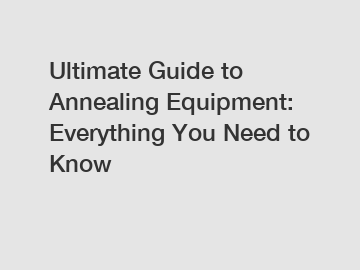Ultimate Guide to Annealing Equipment: Everything You Need to Know
Annealing is a crucial process in many industries, such as manufacturing, metalwork, and even glass production. It involves heating a material to a specific temperature and then slowly cooling it, to make it softer and more malleable. Annealing equipment is essential for achieving the desired results in this process. In this ultimate guide, we will explore everything you need to know about annealing equipment.
Types of Annealing Equipment.
There are several types of annealing equipment available, each designed for specific materials and applications. Some common types include:

1. Annealing Furnaces: These are large, insulated chambers used to heat materials to their annealing temperature. They often have precise temperature controls and can be electrically or gas heated.
2. Salt Baths: Salt baths are used for annealing smaller parts or materials that require a controlled atmosphere during heating. The salt helps regulate the temperature and protect the material from oxidation.
3. Induction Annealers: Induction annealing uses electromagnetic induction to heat the material quickly and efficiently. It is often used for high-volume production and is known for its precise control over temperature.
Key Features to Consider.
When choosing annealing equipment, there are several key features to consider to ensure you get the best results:
1. Temperature Control: Look for equipment that offers precise temperature control to achieve the desired annealing temperature accurately.
2. Cooling Rate: The cooling rate is also crucial for achieving the desired material properties. Some equipment may offer adjustable cooling rates to meet specific requirements.
3. Capacity: Consider the size and capacity of the equipment, as it needs to accommodate the size and quantity of parts you will be annealing.
4. Energy Efficiency: Look for equipment that is energy-efficient to help reduce operating costs and environmental impact.
Maintenance and Safety Tips.
Proper maintenance of annealing equipment is essential to ensure consistent performance and prolong its lifespan. Follow these tips to keep your equipment in top condition:
1. Regular Cleaning: Clean the equipment regularly to remove any debris or contaminants that could affect its performance.
2. Calibrations: Schedule regular calibrations to ensure the equipment is operating at the correct temperatures and cooling rates.
3. Safety Precautions: Always follow safety guidelines when operating annealing equipment, including wearing appropriate protective gear and ensuring proper ventilation.
Conclusion.
Annealing equipment is a vital tool for many industries, offering a controlled and efficient way to heat treat materials. By understanding the different types of annealing equipment, key features to consider, and maintenance tips, you can ensure the best results for your annealing processes. Whether you are annealing metal, glass, or other materials, having the right equipment is essential for achieving the desired properties.
If you have any questions or need assistance with choosing the right annealing equipment for your needs, please feel free to contact us. Our team of experts is always ready to help you find the best solution for your annealing requirements.
Want more information on heating coil design, screw rod high frequency quenching supplier, how does induction heating coil work? Feel free to contact us.
74
0
0


Comments
All Comments (0)